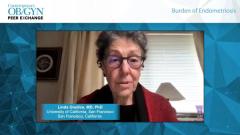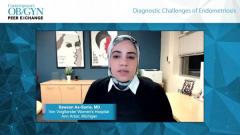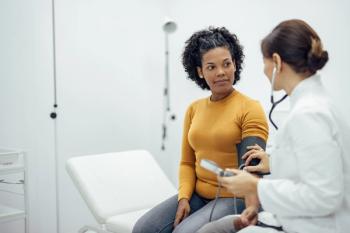
Diagnostic Challenges of Endometriosis
Hugh Taylor, MD, along with a panel of experts, discuss the different challenges of diagnosing endometriosis as well as explaining why there is commonly a delay in diagnosis.
Episodes in this series

Hugh Taylor, MD: Let’s talk about challenges in diagnosing endometriosis. Rob, what are our challenges? We’ve got some awareness. We realize we have to ask about it and pay attention to it. But what are other challenges in diagnosing endometriosis?
Robert Taylor, MD, PhD: The biggest challenge in establishing a diagnosis of endometriosis is the various manifestations of the disease. Sometimes a few small lesions that can’t be detected by any radiological means would go undetected if we didn’t do an operative procedure. As Linda pointed out, that’s the way we traditionally did our diagnosis. At laparoscopy, biopsies and things like that could be taken. We’ve moved to a much more clinical diagnosis of endometriosis, and that’s made for more variability among physicians and clinicians. We’ll speak in the next several minutes about novel approaches to diagnosis. Those will be fun to talk about. It’s exciting to think that we might have more tools that would allow us to be better at making a definitive diagnosis of endometriosis.
Hugh Taylor, MD: Susie, I’ve heard you give a whole lecture on this. If you could, give us a basic summary though on how we can differentiate endometriosis from other disorders that cause pelvic pain. Can you give us a brief overview of how you make that differential diagnosis?
Sawsan As-Sanie, MD: I’d certainly include endometriosis at the top of my differential diagnosis in any patient who has pelvic pain that worsens with their menses, [but also]…nonmenstrual pelvic pain…. We can have a discussion a little later about when we decide to proceed with surgery for the diagnosis and treatment of endometriosis. But we’ll all agree that there are many situations in which the clinical diagnosis of endometriosis is appropriate based on symptoms and indoor imaging, and proceeding with empiric medical therapy is important.
But patients with pelvic pain, with or without endometriosis, have a very high likelihood of having coexisting pain conditions. One of the most common includes myofascial pain or pain that arises from pelvic muscles, indoor joints, indoor abdominal wall, and low back. Doing a comprehensive physical exam for musculoskeletal sources of pain is always something we do during the initial evaluation of patients with pain.
Looking for other symptoms that might point to underlying bladder etiologies or bowel etiologies that could coexist with endometriosis is also important. Does the patient have urinary symptoms, like pain with urination, pain with full-bladder urinary frequency, or urgency? Do they have bowel symptoms, like bloating or pain with bowel movements? All of these could coexist because of endometriosis or other underlying pain conditions. I generally start with empiric treatment for endometriosis. If their symptoms don’t improve, then I collabore with physicians and appropriate specialties like urology or gastroenterology to investigate those other symptoms. It’s a comprehensive interdisciplinary and multisystem approach.
Hugh Taylor, MD: I usually get an ultrasound on patients who have significant pain. You can rule out many of the other types of physical findings that would lead to pelvic pain, cysts, fibroids, etc. For bladder pain and bowel pain that occurs predominantly around the time of menses, I’m always suspicious that it’s secondary to endometriosis and start with an empiric treatment.
Sawsan As-Sanie, MD: I absolutely agree. It’s primarily those patients whose symptoms don’t improve with those treatments. Do we become a little more aggressive about exploring those other options?
Hugh Taylor, MD: Try a treatment. If it doesn’t go away, then we could be fairly concerned that we need to look for other etiologies. Despite our recognition of endometriosis, we know there’s this horrific delay in diagnosing endometriosis. Many patients go for years suffering from pelvic pain without getting a diagnosis and a definitive treatment. Linda, do you want to comment on a few things we can do to potentially combat that terrible delay in diagnosing and treating endometriosis?
Linda Giudice, MD, PhD: The first approach is heightened awareness. Thinking about endometriosis as a diagnosis is the first step. Laparoscopy is, as we know, the gold standard. But there’s a pressing need to increase the utilization of some of the imaging techniques that have pretty good sensitivity and specificity for identifying endometriomas as well as deep infiltrating disease. The superficial peritoneal disease isn’t well detected by those approaches. A number of groups are looking for noninvasive or minimally invasive diagnostics to determine the presence or absence and maybe even stage. It’s hard to believe that in 2023, we still don’t have a reliable alternative to surgery. I’m hopeful for imaging, and I’m increasingly hopeful for molecular diagnostics.
Hugh Taylor, MD:I hope so. That would make it easy. For now, we need to increase awareness and do exactly what we’re trying to do, which is to help make individuals and the public aware of so that we can recognize it. We need individuals to be not afraid to speak up. We need health care providers, including primary care doctors and pediatricians, who first see them to be aware of the disease and recognize it.
TRANSCRIPT EDITED FOR CLARITY
Newsletter
Get the latest clinical updates, case studies, and expert commentary in obstetric and gynecologic care. Sign up now to stay informed.
























